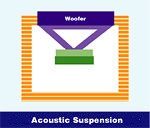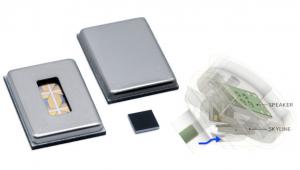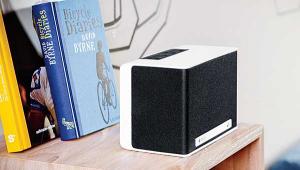Bass-ic Training Subwoofer Designs
 Bass-Reflex Enclosure: Utilizing a ported design, this is one of the two most common sub enclosure types today. Pressure waves from the back of the woofer cone excite an air mass in a port (or ports), producing low-bass output that augments the waves generated by the front of the cone. The result is an additional 3 dB of output in the octave of the system's cutoff frequency. Although 3 dB may not seem like much, to gain it through amplification would take twice the amount of power. This design will also boost previously inaudible fundamentals up to an enjoyable level. The drawback of a bass-reflex design is that the response rolls off rapidly below the cutoff frequency. Phase shift may also alter the character of bass transients. Another drawback is the potential for port noise. Misalignment of box and port parameters relative to the driver may alter the character of the bass by introducing transient ringing.
Bass-Reflex Enclosure: Utilizing a ported design, this is one of the two most common sub enclosure types today. Pressure waves from the back of the woofer cone excite an air mass in a port (or ports), producing low-bass output that augments the waves generated by the front of the cone. The result is an additional 3 dB of output in the octave of the system's cutoff frequency. Although 3 dB may not seem like much, to gain it through amplification would take twice the amount of power. This design will also boost previously inaudible fundamentals up to an enjoyable level. The drawback of a bass-reflex design is that the response rolls off rapidly below the cutoff frequency. Phase shift may also alter the character of bass transients. Another drawback is the potential for port noise. Misalignment of box and port parameters relative to the driver may alter the character of the bass by introducing transient ringing.
 Closed Box: Often referred to as acoustic suspension, this design also has positive and negative characteristics. Typically, the enclosure is much smaller than a ported application using the same size woofer, but more amplifier power is required to achieve the same level of output. Low frequencies roll off much more gradually below the cutoff frequency than with a ported design, so there can be more usable low-frequency energy, albeit at a reduced level. An argument can be made that "room gain" from placement near room boundaries somewhat compensates for this rolloff.
Closed Box: Often referred to as acoustic suspension, this design also has positive and negative characteristics. Typically, the enclosure is much smaller than a ported application using the same size woofer, but more amplifier power is required to achieve the same level of output. Low frequencies roll off much more gradually below the cutoff frequency than with a ported design, so there can be more usable low-frequency energy, albeit at a reduced level. An argument can be made that "room gain" from placement near room boundaries somewhat compensates for this rolloff.
 Bandpass: In a bandpass sub, the woofer or woofers are entirely concealed within a dual-chambered enclosure. The chamber behind the woofer(s) is the normal "enclosure" and can be either sealed or ported. A second chamber in front of the woofer(s), also contained within the enclosure, functions as an acoustic filter, allowing only low frequencies to emerge through a tuned port. This effectively eliminates the need for a crossover but doesn't allow for variable frequency attenuation. It does allow the woofer(s) to be connected directly to the amplifier for increased damping (cone control), and there's less harmonic distortion than with more-conventional designs. The major drawback is that you often can't hear the internal woofer(s) distorting (due to a poor signal or overamplification) until it's too late—the woofer has blown.
Bandpass: In a bandpass sub, the woofer or woofers are entirely concealed within a dual-chambered enclosure. The chamber behind the woofer(s) is the normal "enclosure" and can be either sealed or ported. A second chamber in front of the woofer(s), also contained within the enclosure, functions as an acoustic filter, allowing only low frequencies to emerge through a tuned port. This effectively eliminates the need for a crossover but doesn't allow for variable frequency attenuation. It does allow the woofer(s) to be connected directly to the amplifier for increased damping (cone control), and there's less harmonic distortion than with more-conventional designs. The major drawback is that you often can't hear the internal woofer(s) distorting (due to a poor signal or overamplification) until it's too late—the woofer has blown.
- Log in or register to post comments






















































